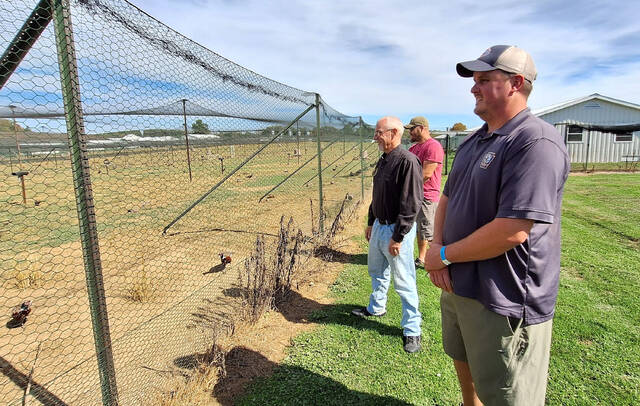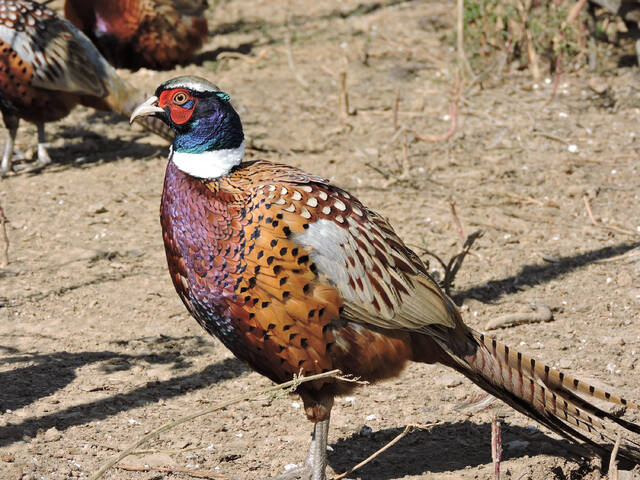More than 215,000 pheasants to take flight across Pennsylvania this fall and winter
Pennsylvania hunters will be able to pursue close to a quarter million pheasants this fall and winter, including some that have a special marking.
Staff members of the Pennsylvania Game Commission are preparing to release birds at least nine times over the various hunting seasons.
Pheasant hunting begins with a youth season Oct. 11-18. The general season continues Oct. 25-Nov. 28, including Sundays. The late season that does not include Sunday hunting runs Dec. 15-24 and Dec. 26-Feb. 28.
For this fall and winter, the agency anticipates releasing between 215,000 and 220,000 pheasants. Last year was a record growing year with about 230,000 pheasants.
“Last year was kind of the gold standard,” Ian Gregg, the PGC’s wildlife operations division chief, said. This year’s numbers will be in line with what was produced during 2021 through 2023.
The agency raises pheasants for western Pennsylvania at the Southwest Game Farm in Armstrong County. The Loyalsock Game Farm in Lycoming County produces pheasants for the eastern half of the state.
Gregg said the pheasants will be released in anticipation of the youth season, the opening of the regular season, one release right after Christmas and two for the start of 2026. “So those are our normal nine, which we’ve been doing for several years now,” he said.
Last year, the agency made arrangements with a chick supplier to hold some back as an insurance policy against a possible avian influenza outbreak.
Fortunately, there wasn’t an outbreak, and the agency was able to purchase about 8,000 of those birds and release them in February across the state. “We have that same set up for this year, so they’re holding those backup breeders in reserve,” he said.
With the contingency plan, the February stockings are not planned like the normal nine stockings. “If we don’t have any disease issues, we’ll get that late season stocking,” he said.
Leg bands
Some hunters may find a pheasant with a leg band this year. The agency did a harvest rate study 10 years ago and is looking to do it again this year. “There have been a lot of changes in the last 10 years,” Gregg said. One notable change is the birds were stocked that were about 50% male and female and now it’s 75% males.
The agency also provides more stocking information on its website to help hunters have a better idea on where and when to find birds. “The hunters can’t see exact times and locations for stockings but are dialed in a little bit more on where and when to go. That wasn’t around 10 years ago,” he said.
About 1 in every 25 to 30 birds will have a silver band on its leg that has a phone number for the successful hunter to call. “One of the metrics that we use to evaluate success of the propagation program is harvest rate, because that’s basically return on investment,” he said.
With the money and staffing the agency invests in pheasants, he said it’s important to know the harvest rates. “We want it to be a safe and fair chase hunting experience, but within those parameters, we want as many of those pheasants being harvested by hunters.”
The reports will help the agency know when and where the birds were harvested by hunters throughout the five-month season.
“We will be using the results to evaluate all the changes that have happened over the past 10 years and also to look at what the harvest rates are now to see what are some things that we might be able to tweak to further increase harvest rates,” he said.
In the 2015 study, about 50% of the birds were shot by hunters.
Where pheasants are stocked
The agency releases birds on land where hunters have access such as state game lands, state forests and partnerships with private landowners.
The agency’s website, pa.gov/agencies/pgc, has an interactive map that provides stocking dates and anticipated stocking weeks to help hunters know where to go. Gregg suggests hunters check the webpage to see if there are any changes to the places where hunters normally hunt or if they are looking for additional places to go.
The agency requires hunters to have a pheasant permit to hunt the birds. The permits are $26.97 for adults and free to junior hunters.
For the 2024-25 season, he said, there were about 55,000 adults and about 20,000 youth permit hunters. He added some senior lifetime license holders also include the pheasant privilege. “So in terms of our total number of pheasant hunters in the state, it’s probably 75,000 to 80,000,” Gregg said.
Raising pheasants
Shane Reed, superintendent of the Southwest Game Fame, said it’s been a good growing year for the pheasants. “We had a lot of rain early in the year that kept the fields full of cover. The birds look good,” he said.
Gregg said they did have some weather challenges this year.
“They had a lot of rain early and then it was dry later, which was partly good and partly bad,” Gregg said. “I’d say the bird survival on both farms was a little bit below average this year, but still we are going to have the typical numbers stocked in the fall,” he said.
About 75% will be males with the familiar white ring on their necks and colorful plumage. Hens are more camouflage brown in color.
Pennsylvania does not have a substantial wild pheasant population, and the agency provides birds as a put-and-take resource for hunting.
Both roosters and hens are legal game. “Males are generally preferred by hunters, but they’re also more expensive to buy and raise. So, it’s sort of a combination of keeping it somewhat of a natural looking hunt, but also for the bang for the buck for our pheasant permit buyers to keeping the program affordable,” Gregg said.
In the future, Gregg is optimistic the agency will be producing more pheasants each year. “We have a project that hopefully will be getting underway this fiscal year here at the Southwest Farm to replace our current brooder houses which are small and older and more labor intensive with a setup that’s more similar to the Loyalsock Farm with four big, more modernized brooder houses,” he said.
A modern facility will provide the agency more room to buy chicks to start on the front end and it should improve the survival rate because the staff will be able to better control the humidity and temperature.
Regarding overall numbers, Gregg didn’t have a goal in mind, but said, “we would like to gradually increase that over the next 5 to 10 years, within the logistical limitations that we have.”
Reed added, “Our biggest determining factor is weather. I mean, you get cold, wet rain on young birds, you have higher mortality,” he said. The heat of this summer was also a challenge as well.
Reed said the farms have a biosecurity plan to help reduce the chances of diseases like avian influenza from impacting the birds, including sanitation measures for the workers’ shoes as well as the tires on the vehicles that travel through the pens and buildings. “We’ve had this plan in place for years now,” he said.
Hunting for pheasants
Chet Spruell, 65, of Somerset, has been enjoying pheasant hunting for more than a half century. He enjoys hunting and he has guided others over the years.
He got his first English setter for his 16th birthday and he has had hunting dogs ever since.
For those who want to hunt pheasants, he said, “Do your homework. Most of the Game Commission personnel that I know of will steer you in the right direction, as far as where they are stocking.”
He also encourages hunters to go with someone who has a bird dog. “I know from years past, without a dog, it’s tough to get pheasants up in the air. They’re tough to find. They burrow down in the grass, they don’t move, they’re hard to see,” he said.
When a ring-neck flushes it can be a challenge to hit as the birds are moving fast. “Aim for the head. If you can pick out the head, you’ll probably hit the bird. If you just shoot at the whole bird, you’re probably going to miss,” he said about shooting behind the fast-moving target. “Aim small, miss small.”
Spruell likes watching his dogs work and seeing birds take flight. “It’s just a blast to be out there, it really is,” he said.
It’s also great exercise. “You’re constantly moving. You are watching the dogs, you’re looking for birds, you’re walking back and forth and chatting with your buddies, it’s an active form of hunting,” he said.
Remove the ads from your TribLIVE reading experience but still support the journalists who create the content with TribLIVE Ad-Free.


